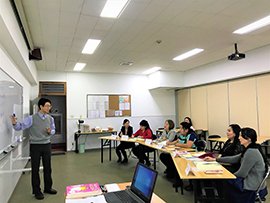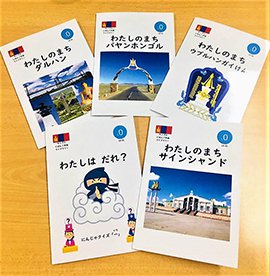“It’s Hot, Mongolia!” Japanese-Language Teaching Method Training Program for Regional Teachers 2020
Mongolia-Japan Center for Human Resources Development
MITSUMOTO Tomoya
Fiscal 2019 Initiatives
In fiscal 2019, I was able to successfully hold spring, summer and autumn Japanese courses at the Japanese-language training sector of the Mongolia-Japan Center for Human Resources Development (hereinafter the “Center”), where I am dispatched. (598 people took the courses in total). The launch of a “Japanese course for children” and a “Course for advanced-level exams” can be cited as major initiatives. Additionally, projects I was commissioned with included the Japanese course for candidate “technical intern trainees (nursing),” which I also ran in fiscal 2018, as well as being newly-entrusted with publicizing the JFT-Basic (The Japan Foundation Test for Basic Japanese), which is also connected to the “Specified Skilled Worker” visa, within Mongolia, and supporting Japanese-language teachers and undertaking research activity. Japanese-Language Specialists have been undertaking a variety of activities in partnership with the Center’s Japanese-language training sector and the Mongolian Japanese Language Teachers Association, but in this report I will discuss the “Japanese-Language Teaching Method Training Program for Regional Teachers,” which I carried out in January 2020 as one part of support for Japanese-language education as a whole in Mongolia.
Japanese-Language Teaching Method Training Program for Regional Teachers 2020

There was plenty of enthusiasm inside the classroom,
while outside it was 30 below zero
At Japanese-language educational institutions for primary-lower secondary school students in Mongolia, a textbook known as “Nihongo Dekirumon” (hereinafter “Dekirumon”), which was created by the Mongolian Japanese Language Teachers Association, is beginning to be widely used. This textbook is teaching material that was created while also taking into account the JF Standard for Japanese-Language Education (a conceptual framework for Japanese-language education that was developed by The Japan Foundation). However, regional Japanese-language teachers do not have the same opportunities to participate in study groups and training programs as teachers in the capital city of Ulaanbaatar, and so they have had almost no opportunities for learning what the principles of this textbook are and how to teach using it. In addition, since they are teaching in locations scattered about Mongolia’s broad land area, the connections between the teachers are weak, so they do not really have anyone they can readily talk to about their classes either. In light of this situation, I planned a three-day teaching method training program for regional teachers for the winter term vacation.
At the orientation on the first day, I began with positioning the training session as a time for summing up the problems and challenges that the teachers experience in their everyday classes, and for resolving them. Next, I had a staff member from the Center conduct a class using “Marugoto: Japanese Language and Culture” (developed by The Japan Foundation), which like Dekirumon was created based on the concepts of the JF Standard for Japanese-Language Education. I had the teachers participate in the class from the standpoint of learners. By venturing to use a textbook that differed only slightly, in the reflection that followed, it was apparent that the teachers were encouraged to understand the flow of Dekirumon classes and the purposes and key points of each section, and that the differences compared to their own everyday lessons gave rise to a lot of realization and learning.
On the second day, I introduced the “strategy of reading according to purpose” and “Tadoku reading.” These are two approaches to “reading comprehension,” which children and students are said to struggle with. With regard to the talk on the strategy, the teachers said the strategy “is practical and looks like it will be immediately useful.” The response to Tadoku reading was extremely good also: “I want to create a Tadoku reading book corner at my own school as well!”, “I will promote it at my child’s school also” and “I want to write a Tadoku reading book myself!” were among the enthusiastic comments I received.
On the third day, the teachers undertook practice Dekirumon classes in pairs that we had decided on the first day, with the remaining participants providing comments. Apparently, the participants had met each other before at symposiums and so on, but having them do the practice classes in pairs rather than individually appeared to deepen their friendships, and they talked with one another for hours after class and at the hotel. They also formed a group on social media where they shared material from the training program, and photos from the day. Partly as a result of these outcomes, the feedback from the teachers after the training ended included that “being able to study together was enjoyable” and that “I am happy that a network with other regional teachers has been created.”
Following That, and from Here Forward

Five completed original Tadoku reading books
Regrettably, from the end of January 2020, immediately after this training program, schools throughout Mongolia were closed due to the impact of COVID-19, and the teachers ended up starting their summer vacations without being able to put into practice in their classrooms what they had learned at the training. However, from here forward also, I want to help strengthen the regional teachers’ network and coordinate with teachers in Ulaanbaatar as well, in order to contribute to invigorating Japanese-language education for primary-lower secondary school students as a whole in Mongolia.
(Postscript: The teachers got in touch with one another via their social media group, and in June 2020, they completed Tadoku reading books that introduce their respective towns. The books are crammed with the teachers’ love for their home towns, all of which are very charming. The books will be released online as well, but I sincerely hope that the day will soon come when the physical versions are in place at the respective schools’ Tadoku reading book corners, and are being enthusiastically read by the children and students).
- What We Do Top
- Arts and Cultural Exchange [Culture]
- Japanese-Language Education Overseas [Language]
- Japanese-Language Education Overseas [Language] Top
- Learn Japanese-language
- Teach Japanese-language
- Take Japanese-Language Test
- Know about Japanese-language education abroad
- The Japanese-Language Institute, Urawa
- The Japanese-Language Institute, Kansai
- Japanese-Language Programs for Foreign Specified Skilled Worker Candidates
- Japanese Language Education for Japanese Children Resident Overseas and for the Descendants of Migrants
- Archives
- Japanese Studies and Global Partnerships [Dialogue]
- JF digital collection
- Other Programs / Programs to Commemorate Exchange Year
- Awards and Prizes
- Publications
